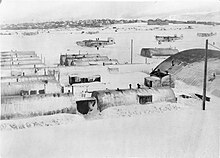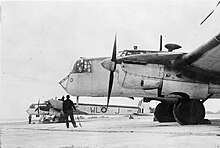RAF Iceland
| RAF Iceland No. 30 (Coastal) Wing RAF 29th (Training) Wing RFC | |
|---|---|
 | |
| Active | July 1941 - July 1945 |
| Country | |
| Branch | |
| Type | Royal Air Force command |
| Role | Anti-submarine warfare Commerce raiding Aerial reconnaissance Air-sea rescue Meteorological Flight |
| Part of | RAF Coastal Command |
| Engagements | Second World War |
| Commanders | |
| Notable commanders | Air Commodore Cecil George Wigglesworth CB, AFC |

RAF Iceland is a former Royal Air Force command which controlled RAF units within Iceland. The command was operational between July 1941 and July 1945 during the Second World War, the unit was previously No. 30 Wing RAF.[1]
History

RAF Iceland was formed on 2 July 1941, as an overseas command, within RAF Coastal Command.[2] The following year, by April 1942, the command controlled two airfields in Iceland with four operational units.[3] No. 269 Squadron was operating Lockheed Hudson bomber, reconnaissance, transport, and maritime patrol aircraft, out of RAF Kaldadarnes,[4] which was situated near the town of Selfoss. RAF Reykjavik, at Reykjavík Airport, was home to No. 330 Squadron which operated with Northrop N-3PB Nomad, a single-engined American floatplane,[5] No. 612 Squadron which was equipped with Armstrong Whitworth Whitley, a British medium bomber aircraft,[6] and No. 1407 (Meteorological) Flight RAF which used Lockheed Hudson, an American light bomber and coastal reconnaissance aircraft.[7][3] The command controlled the Iceland Ferry Control Unit which was formed at Reykjavik on 11 August 1942.[1]

By April 1943, No. 612 Squadron had returned to the UK, to RAF Thorney Island.[6] No. 1407 (Meteorological) Flight RAF remained at RAF Reykjavik, but was now using Handley Page Hampden, a British twin-engine medium bomber,[8] and No. 330 Squadron had moved to RAF Oban,[5] but operated a detachment of Northrop N-3PB Nomad, at RAF Reykjavik[8] July 1944 saw only RAF Reykjavik in use. No. 1407 (Meteorological) Flight RAF was still based in Iceland and was back to operating with Lockheed Hudson.[9] No. 86 Squadron was now based at RAF Reykjavik and was equipped with Consolidated Liberator, a four-engined American heavy bomber,[10] and No. 279 Squadron operated a detachment at this point, with Lockheed Hudson.[9] By July 1945 it was down to a single unit.[11] No. 1407 (Meteorological) Flight RAF had disbanded at RAF Reykjavik on 1 August 1944 to become No. 251 Squadron.[7] The squadron was operating out of RAF Reykjavik, equipped with Boeing Fortress II, a four-engined American heavy bomber,[12] when the RAF Iceland command disbanded, during July 1945.[2]
History of No. 30 Wing RAF
No. 30 Wing RAF as formed as 29th (Training) Wing RFC on 1 June 1917 at Edinburgh controlling Montrose Aerodrome and Turnhouse Aerodrome. On the formation of the Royal Air Force it was transferred to 21st Group RAF and moved to Montrose on 22 July 1918. The wing was disbanded during October 1918.[13]
The wing was reformed on 22 March 1941 as No. 30 (Coastal) Wing RAF at RAF Reykjavik and became RAF Iceland on 2 July 1941.[13]
Air Officer Commanding
- Note: The ranks shown are the ranks held at the time of holding the appointment of Air Officer Commanding, RAF Iceland.[2]
| Rank | name | from |
|---|---|---|
| Air Commodore | William Harold Primrose | unknown |
| Air Commodore | Cecil George Wigglesworth | 20 September 1943 |
| Air Commodore | Gerald Harold Boyce | 4 January 1945 |
See also
References
Citations
- ^ a b Sturtivant, Hamlin & Halley 1997, p. 193.
- ^ a b Delve 1994, p. 58.
- ^ Jefford 2001, p. 84.
- ^ a b Jefford 2001, p. 89.
- ^ a b Jefford 2001, p. 101.
- ^ a b Lake 1999, p. 87.
- ^ a b Delve 1994, p. 64.
- ^ a b Delve 1994, p. 73.
- ^ Jefford 2001, p. 54.
- ^ Delve 1994, p. 80.
- ^ Jefford 2001, p. 80.
- ^ a b Sturtivant, Hamlin & Halley 1997, p. 314.
Bibliography
- Delve, K. (1994). The Source Book of the RAF. Shrewsbury, UK: Airlife Publishing Ltd. ISBN 1-85310-451-5.
- Jefford, C.G. (2001). RAF Squadrons, a Comprehensive Record of the Movement and Equipment of all RAF Squadrons and their Antecedents since 1912, 2nd Edition. Shrewsbury, UK: Airlife Publishing Ltd. ISBN 1-84037-141-2.
- Lake, Alan (1999). Flying Units of the RAF. Shrewsbury, UK: Airlife Publishing Ltd. ISBN 1-84037-086-6.
- Sturtivant, R.; Hamlin, J.; Halley, J. (1997). Royal Air Force flying training and support units. UK: Air-Britain (Historians). ISBN 0-85130-252-1.

